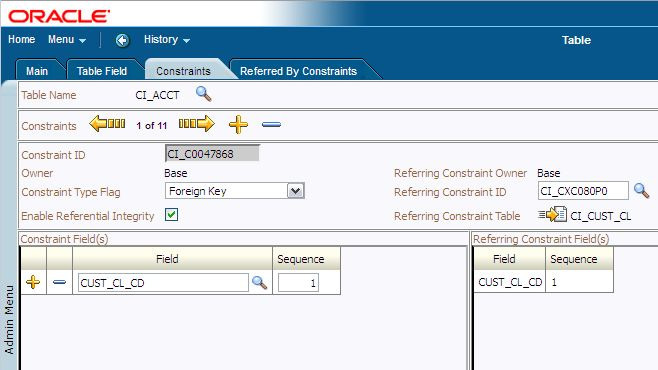Tables - Constraints
Select Admin Menu, Table and navigate to the Constraints tab to view the constraints defined on the table.

Tables Object View - Constraints
Description of Page
The fields on this page are protected as only the product development group may change them.
This page represents a collection of constraints defined for the table. A constraint is a field (or set of fields) that represents the unique identifier of a given record stored in the table or a field (or set of fields) that represents a given record's relationship to another record in the system.
Constraint ID is a unique identifier of the constraint.
Owner indicates if this is owned by the base package or by your implementation (Customer Modification)
Constraint Type Flag defines how the constraint is used in the system:
• Primary Key represents the field or set of fields that represent the unique identifier of a record stored in a table.
• Logical Key represents an alternate unique identifier of a record based on a different set of fields than the Primary key.
• Foreign Key represents a field or set of fields that specifies identifying and non-identifying relationships to other tables in the application. A foreign key constraint references the primary key constraint of another table.
• Conditional Foreign Key represents rare relationships between tables where a single field (or set of fields) may reference multiple primary key constraints of other tables within the application as a foreign key.
When Enable Referential Integrity is checked, the system validates the integrity of the constraint when a row in the table is modified.
Referring Constraint Owner indicates if this is owned by the base package or by your implementation (Customer Modification).
Referring Constraint ID is the Primary Key constraint of another table whose records are referenced by records stored in this table.
Referring Constraint Table displays the table on which the Referring Constraint ID is defined. You can use the adjacent go-to button to open the table.
Additional Conditional SQL Text is only specified when the constraint is a Conditional Foreign Key. The SQL represents the condition under which the foreign key represents a relationship to the referring constraint table.
Note:Additional Conditional SQL Syntax. When specifying additional conditional SQL text, all table names are prefixed with a pound (#) sign.
The Constraint Field grid at the bottom of the page is for maintaining the field or set of fields that make up this constraint.
Field The name of the table's field that is a component of the constraint.
Sequence The rank of the field as a component of the constraint.
The Referring Constraint Field grid at the bottom of the page displays the field or set of fields that make up the Primary key constraint of the referring constraint.
Field The name of the table's field that is a component of the referring constraint.
Sequence The rank of the field as a component of the referring constraint.
Parent topic